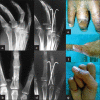Outcome of closed proximal phalangeal fractures of the hand
- PMID: 21886925
- PMCID: PMC3162680
- DOI: 10.4103/0019-5413.83764
Outcome of closed proximal phalangeal fractures of the hand
Abstract
Background: The proximal phalanx (PP) of the fingers is fractured more frequently than the middle or even distal phalanges. The problems of malunion, stiffness and sometimes loss of skin or other soft tissues associated with PP fracture increases the disability. The optimum treatment depends on fracture location, fracture geometry and fracture stability. The objective of the study was to analyse the treatment outcome in a series of closed proximal phalangeal fractures of the hand.
Materials and methods: Eighty-four proximal phalangeal fractures in 68 patients were enrolled from 2007 to 2009. The treatment modalities were broadly categorised into two groups, Group A consisted of conservative treatment, and Group B consisted of surgical treatment. Group A included 47 digits treated with closed reduction (CR) with immobilization (n=43), extension block cast and dynamic traction (n=4), while 37 digits were treated in Group B, which included closed or open reduction (OR) and internal fixation (IF) with K-wires (n=31), OR and IF with stainless-steel wiring (n=2), and mini external-fixator (n=4). Belsky's criteria and Gingrass' criteria were used for assessment of finger injuries and to assess the efficacy of conservative and surgical modalities for closed proximal phalangeal fractures of the hand.
Results: Average period of follow-up was 1 year (range 10-14 months). The excellent to good results seen in Groups A and B were 89% and 92%, respectively. Six complications were seen in Group A, which included four cases with malunion and two cases with digital stiffness. Three complications were seen in Group B, which included one each of malunion, digital stiffness and extensor lag. Overall, maximum poor results (n=4) were seen with CR and buddy strapping.
Conclusion: Conservative treatment is an inexpensive method, particularly suitable for stable fractures, and in patients who are poor candidates for surgery, Surgical modalities have distinct advantage of stable fixation, but with added risk of digital stiffness. Percutaneous pinning is a reliable, most commonly used surgical modality and technically easier. Both conservative and surgical modalities have good efficacy when used judiciously.
Keywords: Proximal phalanx fracture; closed reduction; hand; open reduction.
Conflict of interest statement
Figures







References
-
- Stern PJ. Factures of metacarpals and phalanges. In: Green DP, Hotchkiss RN, Pederson WC, editors. Green's operative hand surgery. 4th ed. Vol. 1. Philadelphia, US: Churchill Livingstone; 1999. pp. 711–57.
-
- Watson-Jones R, Barton NJ. Fractures and Joint Injuries of the hand. In: Wilson JN, editor. Watson-Jones fractures and joint Injuries. 7th ed. Noida: Elsevier Publishers; 2009. pp. 650–95.
-
- Barton N. Internal fixation of the hand. J Hand Surg Br. 1989;14:139–42. - PubMed
-
- Margic K. External fixation of closed metacarpal and phalangeal fractures of digits: A prospective study of one hundred consecutive patients. J Hand Surg Br. 2006;31:30–40. - PubMed
-
- Burkhalter WE. Closed treatment of hand fractures. J Hand Surg Am. 1989;14:390–3. - PubMed
LinkOut - more resources
Full Text Sources
Miscellaneous
